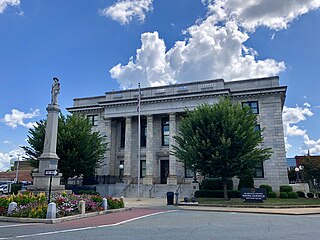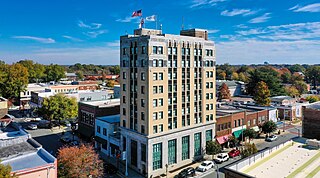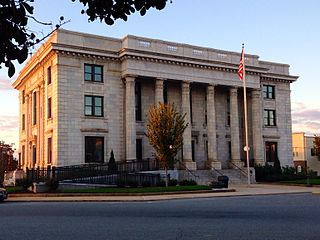
Alamance County is a county in North Carolina. As of the 2020 census, the population was 171,415. Its county seat is Graham. Formed in 1849 from Orange County to the east, Alamance County has been the site of significant historical events, textile manufacturing, and agriculture.

Burlington is a city in Alamance and Guilford counties in the U.S. state of North Carolina. It is the principal city of the Burlington, NC Metropolitan Statistical Area, which encompasses all of Alamance County, in which most of the city is located, and is a part of the Greensboro–Winston-Salem–High Point, NC Combined Statistical Area. The population was 57,303 at the 2020 census, which makes Burlington the 18th-most populous city in North Carolina.

Graham is a city and the county seat of Alamance County, North Carolina, United States. It is part of the Burlington, North Carolina Metropolitan Statistical Area. As of the 2020 census the population was 17,153.

Haw River is a town in Alamance County, North Carolina, United States. It is part of the Burlington, North Carolina Metropolitan Statistical Area. At the 2010 census, the population was 2,298.

Mebane is a city located mostly in Alamance County, North Carolina, United States, and partly in Orange County. The town was named for Alexander Mebane, an American Revolutionary War general and member of the U.S. Congress. It was incorporated as "Mebanesville" in 1881, and in 1883 the name was changed to "Mebane". It was incorporated as a city in 1987. The population as of the 2020 census was 17,768. Mebane is one of the fastest-growing municipalities in North Carolina. Mebane straddles the Research Triangle and Piedmont Triad Regions of North Carolina. The bulk of the city is in Alamance County, which comprises the Burlington Metropolitan Statistical Area, itself a component of the Greensboro-Winston-Salem-High Point Combined Statistical Area. Two slivers in the eastern portion of the city are in Orange County, which is part of the Durham-Chapel Hill Metropolitan Statistical Area, itself a component of the Raleigh-Durham-Chapel Hill Combined Statistical Area.

The Cedarock Historical Farm, located at Cedarock Park in Alamance County, North Carolina, provides an example of life on a farm in North Carolina during the 19th Century. Populated with farm animals, antique and replica farm equipment, and a farmhouse, the Historical Farm provides a fun, education stop while visiting Cedarock Park.

Warrenton Historic District is a national historic district located at Warrenton, Warren County, North Carolina. The district encompasses 202 contributing buildings in the central business district and surrounding residential sections of Warrenton. The district developed between about 1840 and 1926, and includes notable examples of Early Republic, Greek Revival, and Late Victorian architecture. Notable buildings include the Falkener House, Macon Street House, Peter Davis Store, Jones-Cook House, Eaton Place (1843), Sommerville-Graham House by Jacob W. Holt, Presbyterian Church also by Holt, Baptist Church, Methodist Episcopal Church, Miles Hardware Store, Warrenton City Hall, Warrenton Hotel, John Graham School, and the U.S. Post Office.

Halifax Historic District is a national historic district located at Halifax, Halifax County, North Carolina, US that was listed on the National Register of Historic Places in 1970. It includes several buildings that are individually listed on the National Register. Halifax was the site of the signing of the Halifax Resolves on April 12, 1776, a set of resolutions of the North Carolina Provincial Congress which led to the United States Declaration of Independence gaining the support of North Carolina's delegates to the Second Continental Congress in that year.
Kerr Scott Farm, also known as Melville, is a historic home and farm located near Haw River, Alamance County, North Carolina. The vernacular farmhouse was built in 1919, and consists of a 1 1/2-story, frame, center hall plan, hip-roofed main block, with a one-story frame gable-roofed ell built about 1860. The property includes a variety of contributing outbuildings including a farm office, milk house, woodshed, dairy barns, equipment building / machine shop (1941), cow shed, gas / oil house, corn crib (1910), silos, and cow sheds. It was the home of North Carolina governor and United States Senator, W. Kerr Scott (1896-1958) and the birthplace of W. Kerr Scott's son, also a former North Carolina governor, Robert W. Scott.

Glencoe Mill Village Historic District is a national historic district located at Glencoe, Alamance County, North Carolina. It encompasses 48 contributing buildings and 6 contributing structures built between 1880 and 1882 in Glencoe.

Lakeside Mills Historic District is a national historic district located at Burlington, Alamance County, North Carolina. It encompasses 20 contributing buildings built in the 1890s. The district includes a one-story brick mill and ancillary buildings, 16 one-, 1 1/2- and two-story frame houses, and a store building.

West Davis Street–Fountain Place Historic District is a national historic district located at Burlington, Alamance County, North Carolina. It encompasses 138 contributing buildings in a primarily middle-class residential section of Burlington. Most of the dwellings date to the late-19th and early-20th century and include representative examples of Queen Anne and Colonial Revival style architecture.

Downtown Burlington Historic District is a national historic district located at Burlington, Alamance County, North Carolina, United States. It encompasses 40 contributing buildings in the central business district of Burlington, and was added to the National Register of Historic Places in 1990.

Alamance Mill Village Historic District is a national historic district located at Alamance, Alamance County, North Carolina. It encompasses 18 contributing buildings and 1 contributing structure built between 1840 and 1947 in Alamance. The district includes 15 mill houses, a warehouse, and the mill dam and connected remains of the head race.

North Main Street Historic District is a national historic district located at Graham, Alamance County, North Carolina. It encompasses 101 contributing buildings date from the 1850s to 1949 in a predominantly residential section of Graham. The district contains single and multi-family dwellings, two schools, one commercial building and three churches.
Charles F. and Howard Cates Farm, also known as Swathmoor Farm, is a historic farm complex and national historic district located near Mebane, Alamance County, North Carolina. It encompasses 11 contributing buildings, 1 contributing site, and 5 contributing structures on a farm near Mebane. The district includes the two-story double-pile Cates farmhouse and a collection of outbuildings and supporting structures. These include outbuildings probably associated with pickle manufacture such as the packhouse and the office (c. 1920); outbuildings associated with dairying including the multipurpose barn, the well house, and the milk barn ; and the mule barn, gas house, tool shed, pump house, privy, and chicken house. Its owner Charles F. Cates was instrumental in establishing the Woodlawn School.
Henderson Scott Farm Historic District is a historic farm and national historic district located near Mebane, Alamance County, North Carolina. It encompasses 10 contributing buildings on a farm near Mebane. The district includes the Federal style First Henderson Scott House (1836), Greek Revival style Second Henderson Scott House (1849), smokehouse, garage (1918), milk/butter House, Henderson Scott Store (1855), sheep barn, dairy barn 1, chicken house, and wellhouse.
The Oneida Cotton Mills and Scott-Mebane Manufacturing Company Complex, also known as the Scott and Donnell Mill, is a historic hosiery mill building in Graham, Alamance County, North Carolina. It consists of four contributing buildings and one contributing structure. The buildings date from 1882 into the 1940s; all are red-brick except for a small shed-roofed bathroom building from the 1940s. The complex includes the Scott and Donnell Mill, a smokestack (1882), Holt Mill, Scott-Mebane Manufacturing Company, and opener Room.
Mebane Commercial Historic District is a national historic district located at Mebane, Alamance County, North Carolina. It encompasses 30 contributing buildings, and 1 contributing structure in the central business district of Mebane. The district includes one and two-part commercial blocks of one to three stories in height, executed in the Colonial Revival and Neo-Classical styles. The earliest buildings date to about 1905. Notable buildings include two former banks, the Five Star Building, Mebane Enterprise Building, and Jones Department Store Building.
Merge to Fairfield, Hyde County, North Carolina?


















